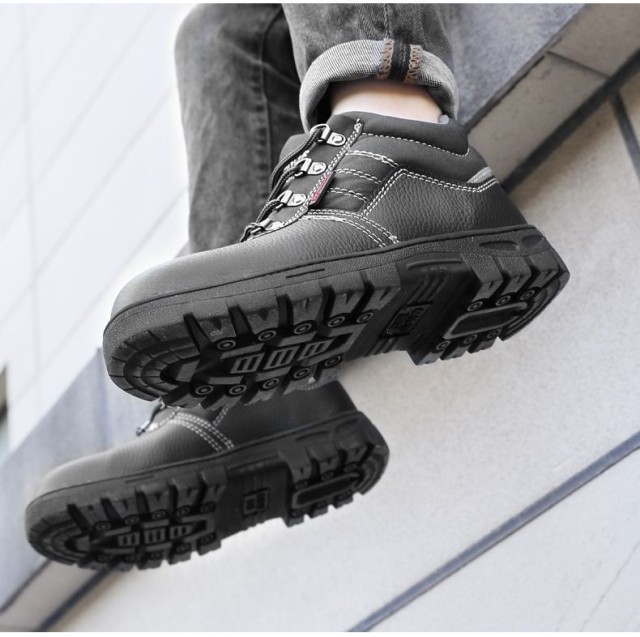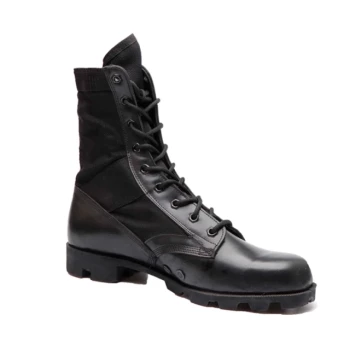Workplace hazards demand specialized footwear solutions. Modern safety boots integrate advanced materials and engineering to address specific risks—from electrical shocks to chemical exposure. This guide decodes how protective features align with certifications like ASTM and ISO, helping you select boots that match your job's unique dangers.
Safety Work Boots as Hazard-Specific Engineering Solutions
Safety boots aren’t just durable footwear; they’re precision tools designed to mitigate identified risks. Research shows that 60% of workplace foot injuries occur due to inadequate protective footwear. Here’s how engineering tackles common hazards:
Material Science: Fire Resistance and Thermal Barriers
- Molten Metal & Extreme Heat: Boots with heat-resistant leather and aluminized reflectors deflect radiant heat. Some designs incorporate aramid fiber linings that withstand temperatures exceeding 500°F.
- Electrical Hazards: Non-conductive materials like rubber or composite toe caps prevent current transfer. ASTM F2413-compliant boots block up to 18,000 volts under dry conditions—critical for electricians.
Hydrophobic Technologies for Water and Chemical Exposure
- Oil & Chemical Spills: Nitrile outsoles outperform vulcanized rubber, resisting degradation from hydrocarbons and acids. Look for ISO 20345 certification indicating chemical penetration resistance.
- Wet Environments: Micro-grooved treads channel liquids away while hydrophobic membranes (e.g., Gore-Tex®) keep feet dry without sacrificing breathability.
Reinforced Structures for Heavy Equipment and Compression Risks
- Impact Protection: Composite or steel toes (ASTM F2412-18a) withstand up to 75 lbs dropped from 1 foot.
- Puncture Resistance: Kevlar® or steel midsoles (marked with a green "PR" shield) stop nails or glass shards from penetrating.
Advanced Tread Patterns for Rough Terrain Navigation
- Slip Resistance: ASTM F1677-2005-certified soles use hexagonal lugs and softer rubber compounds to grip oily surfaces—vital for oil rig workers.
- Uneven Ground: Deep, multi-directional lugs prevent mud buildup, while stabilizing heel cups reduce ankle rolls.
Did you know? Boots combining puncture resistance with electrical hazard protection require careful material selection—conductive metals can’t be used in the shank or sole.
Certifications Decoded: Matching ASTM/ISO Standards to Workplace Threats
Certifications act as your shorthand for hazard-specific validation. Here’s how to interpret them:
| Standard | Hazard Covered | Key Requirement |
|---|---|---|
| ASTM F2413-18 | Electrical Hazards | Blocks 18kV, no current leakage >1mA |
| ASTM F2892-18 | Puncture Resistance | Stops penetration from 270+ lbs of force |
| ISO 20345:2022 | Basic Safety (Toe Impact/Slip) | 200J toe cap, slip-resistant outsole |
| ASTM F1677-2005 | Slip Resistance (Oily Surfaces) | ≥0.3 coefficient of friction on wet steel |
Pro Tip: For environments with multiple risks (e.g., construction sites), prioritize boots listing both ASTM and ISO certifications.
Upgrade Your Safety Footwear with 3515
Distributors and bulk buyers: Partner with 3515 to source certified safety boots engineered for your clients’ unique workplace hazards. From electrical grids to chemical plants, our range combines compliance, comfort, and cutting-edge protection. [Contact our team] to discuss scalable solutions.
Because the right boot doesn’t just protect feet—it safeguards productivity and peace of mind.
Related Products
- Durable Steel Toe Safety Boots Wholesale & Custom Manufacturing
- Wholesale Slip-On Safety Boots Manufacturer - Custom Puncture-Proof & Steel Toe
- Custom Wholesale Leather Safety Boots Direct Factory Manufacturing
- Wholesale Durable Safety Boots | Custom Steel Toe & Puncture-Resistant Manufacturing
- Wholesale Customizable Suede Safety Boots - Puncture-Proof with Velcro Closure
Related Articles
- How to Choose Safety Footwear for Electrical Hazard Jobs: Steel Toe vs. Composite Toe
- How to Choose Between Steel and Composite Toe Boots for Maximum Safety
- Steel Toe Work Boots: Balancing Safety and Comfort for Demanding Jobs
- How to Reduce Steel Toe Boot Risks Without Compromising Workplace Safety
- How Modern Steel Toe Boots Achieve Safety Without Sacrificing Comfort



















